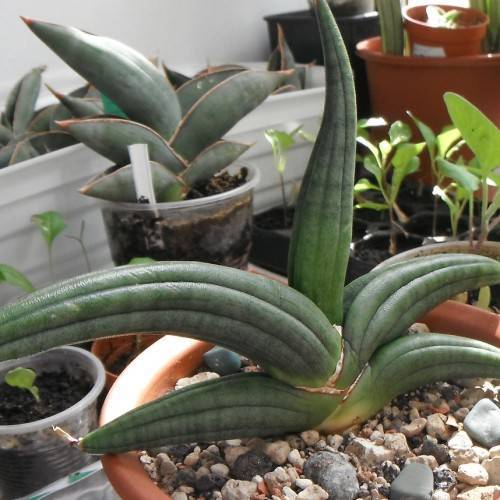
snake plant
Sansevieria patens
Cycle:
Herbaceous Perennial
Watering:
Minimum
Hardiness Zone:
10 - 12
Flowers:
Flowers
Sun:
part shade,part sun/part shade
Leaf:
Yes
Growth Rate:
Low
Maintenance:
Low
Drought Tolerant:
Yes
Salt Tolerant:
Yes
Indoors:
Yes
Care Level:
Low
watering
Snake plants, also known as Sansevieria patens, are versatile African natives that are tough and easy to care for. Water about once a month during the spring and summer when the soil is dry to a depth of 1-2 inches. During the fall and winter months, water the plant once every 3-4 weeks, or more sparingly if the soil is still moist. Always make sure to allow the soil to dry out before re-watering to avoid overwatering the snake plant.
sunlight
Snake plants generally prefer bright indirect sunlight. If grown indoors, it is best to place your snake plant near a south or east facing window. While snake plants can tolerate low light conditions, they will grow faster and healthier with enough light. If placed outdoors, snake plants should be grown in partial shade, ideally in an area where the plant will get several hours of direct morning sunlight (up to 4 hours of direct sun). To prevent sunburn, ensure the plant is gradually introduced to higher light levels. During the summer months (May-September), it is best to be cautious with sunlight exposure as intense afternoon sunlight can be too intense for this species.
pruning
It is recommended to prune Snake Plant (Sansevieria patens) twice a year, once during early spring and again during late summer. To prune the Snake Plant, cut off the leaves at the soil surface with a pair of sharp scissors or gardening shears. When pruning, be sure to leave several inches of leaves on the stem. Pruning will help manage the size of the plant as well as help with airflow so the snake plant can grow larger and healthier. It is also recommended to only prune when necessary, as the plant can become damaged by overpruning.
Hardiness Map
FAQ
Can Snake Plants grow in low light conditions?
Yes, Snake Plants are very tolerant to low light environments and they can survive in almost any kind of light, including fluorescent lighting. They can even survive in areas with no natural light at all. Snake Plants are extremely hardy and can handle a wide range of light conditions, including both direct and indirect light. However, the plants may not thrive or grow as lush or as quickly as plants in brighter light, but they will still survive.
Should Snake Plants be watered frequently?
No, snake plants should not be watered frequently. Snake plants are hardy, drought-tolerant plants, and can withstand dry periods of time. They thrive on limited water, so over-watering can cause their roots to rot. Typically, it is recommended to water snake plants every two to four weeks, depending upon the season. Be sure to always check soil moisture before adding more water, as too much water can cause the leaves to turn yellow or brown.
Could Snake Plants be used as natural air purifiers?
Yes, snake plants can be used as natural air purifiers. These plants are highly efficient at removing a range of toxins from the air, including volatile organic compounds such as formaldehyde, trichloroethylene, xylene, and benzene. Studies have shown that snake plants can reduce indoor air pollutants by as much as 40 to 60 percent when placed strategically around the home. Furthermore, these plants are low-maintenance, easy to care for, and virtually indestructible, making them an ideal choice for those looking to clean up their air quality without spending much time or money.
